Nothing much new to report for September Bloom Day, hosted by Carol at May Dreams Gardens. Anything new in bloom here is from fall planting. Okay, so technically I’m a little premature with fall planting, but patience has never been my strong suit.
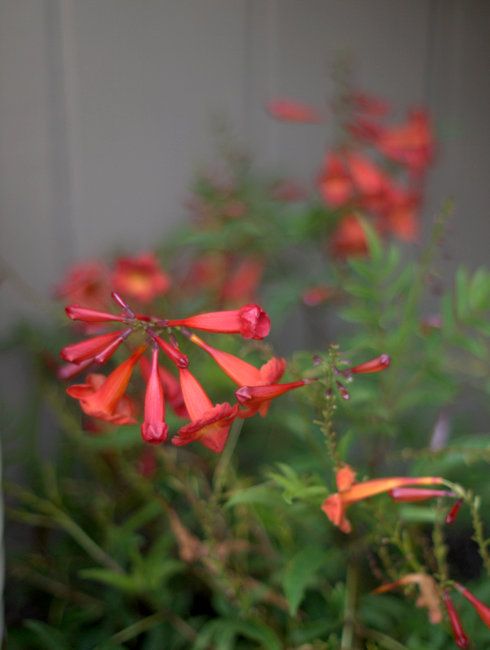
Tecoma ‘Bells of Fire‘ is a newish compact variety that will probably behave more like a shrub than vine.

It’s been tucked into a corner of the narrow planting strip on the east patio, the same strip where Passiflora ‘Witchcraft’ was recently planted adjacent to a now fence-high Tecomaria ‘Hammer’s Rose.’ Vines or vine-like plants seem to be the answer for this awkward little strip. (Both the tecoma and tecomaria come from the tropical bignoniaceae tribe.) When planting the Tecoma ‘Bells of Fire,’ I trained a hose with a steady jet of water into the hole, waiting for the water to top the rim then slowly reabsorb. Waiting and waiting — I never could get the hole to fill, because the soil continually sucked in every drop. At least the drainage is good. The potted agaves are getting moved to this patio for full winter sun, whereas that little potted quiver tree, Aloe dichotoma, has been flourishing in harsh sun here all summer — a very tough customer.
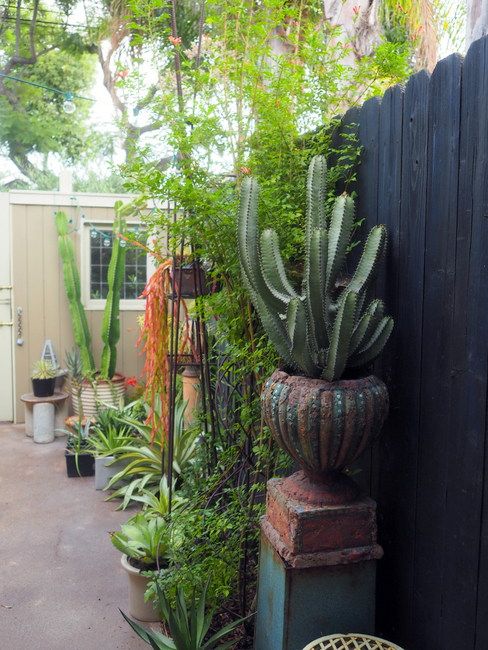
Although it comes with the toughest of bonafides, even the tecomaria has been a struggle to shepherd safely through the dry season in this hellish strip. The photo isn’t very helpful other than to show that the tecomaria, just behind the potted Euphorbia canariensis, has finally topped the fence, with a few light peachy blooms at the tips. If the tecomaria and passiflora want to mingle on the rebar trellis, so much the better. Vines are intrinsically social beings, after all.
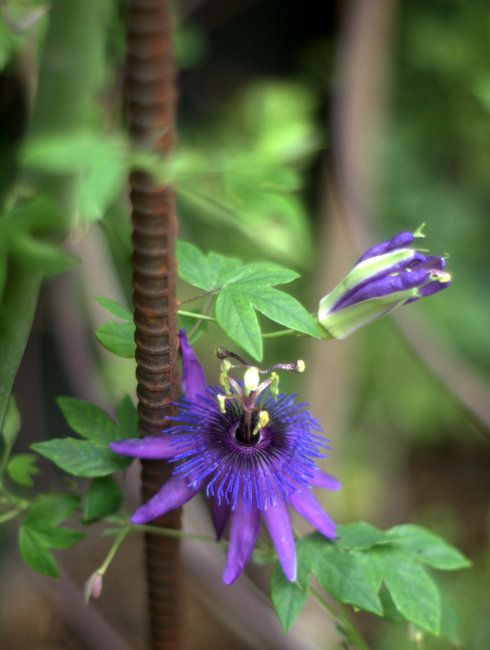
This strip has become a notorious graveyard for plants. The soil seems determined to revert to bone-dry dust. I suspect my neighbor’s palms and lawn on the other side of the fence are the water-hogging guilty parties.
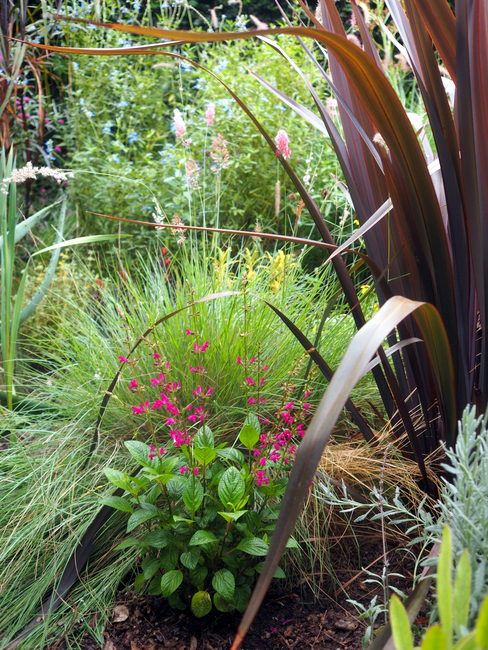
More fall planting. Salvia chiapensis is a long-time, absolutely reliable friend of the garden that has cycled in and out for many years. Of all the salvias I’ve grown, this salvia is a standout for its relatively compact, vase-like shape, willowy habit, long period of bloom, and the toughness of its crinkly, rugose leaves, which never droop mid-day like the thin leaves of the spectacular new hybrids such as ‘Wendy’s Wish’ and ‘Love and Wishes.’ By planting it in fall, it’s a gift for the year-round hummingbirds throughout fall and most of winter. So much easier than messing around with feeders. It’s always available locally, like this beautifully grown specimen from H&H Nursery, whenever I want it back in the garden.
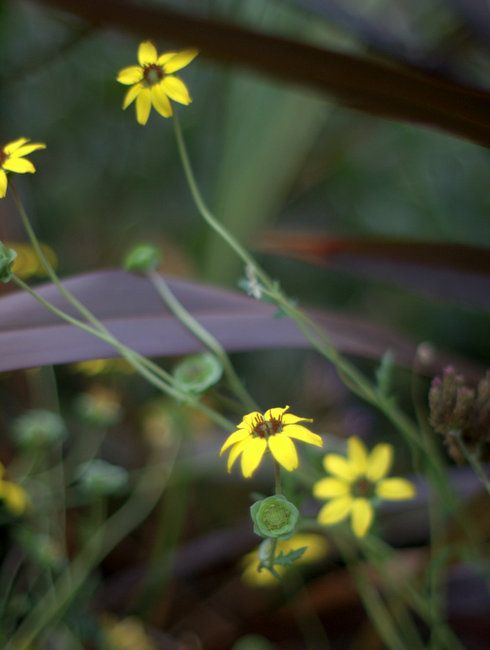
The chocolate daisy Berlandiera lyrata has been in bloom all summer and really does scent a hot mid-day with chocolate perfume.

Agastache ‘Blue Boa’ was planted early/mid summer. Pennisetum ‘Karley Rose’ leans in, a boisterous grass with a big presence. One clump was removed earlier in the summer.
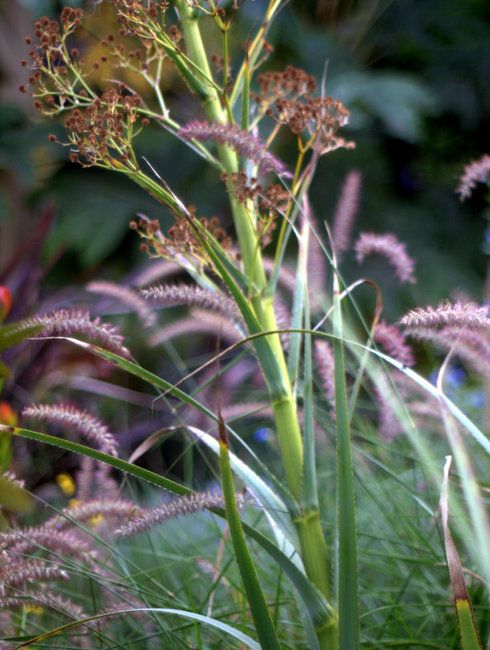
The serrated, strappy leaves belong to Eryngium pandanifolium, whose seedheads are now a rusty brown.
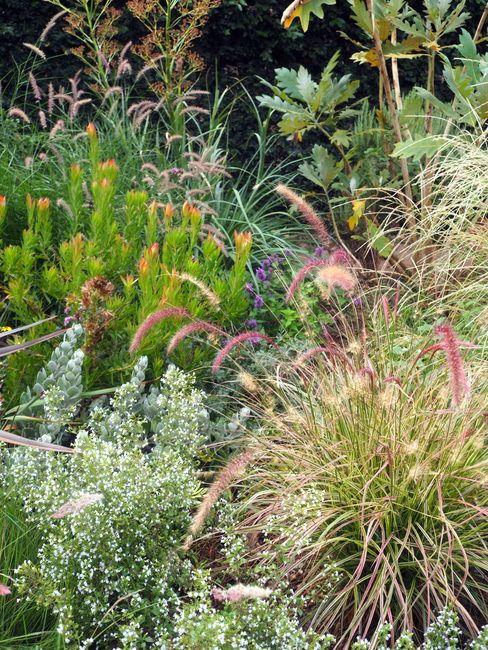
Looking from the back porch. Grasses are Pennisetum ‘Karley Rose,’ in the back, Pennisetum ‘Cherry Sparkler’ in the foreground (replacing a ‘Fairy Tails’ mid summer that had taken on the manners of a playful baby elephant). A glimpse of Miscanthus ‘Little Kitten’ leans in from the right. This miscanthus is not what I would describe as small and kittenish — it’s becoming apparent that if you love grasses, be prepared to split them up into smaller clumps every year, a job for late winter here. Still, I do think our dry, rainless summers are a good match for grasses. No worries of them getting smashed to the ground in rainstorms, and they sail their plumes on surprisingly little supplemental irrigation.
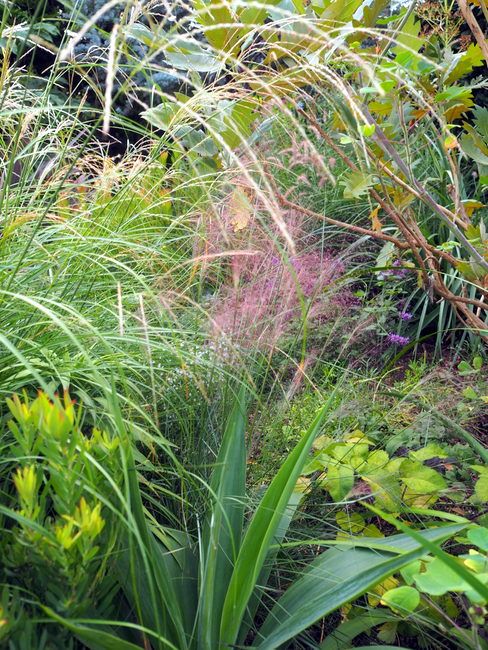
Muhlenbergia ‘Fast Forward’ began ramping up the past week, but it is getting squeezed by Miscanthus ‘Little Kitten’
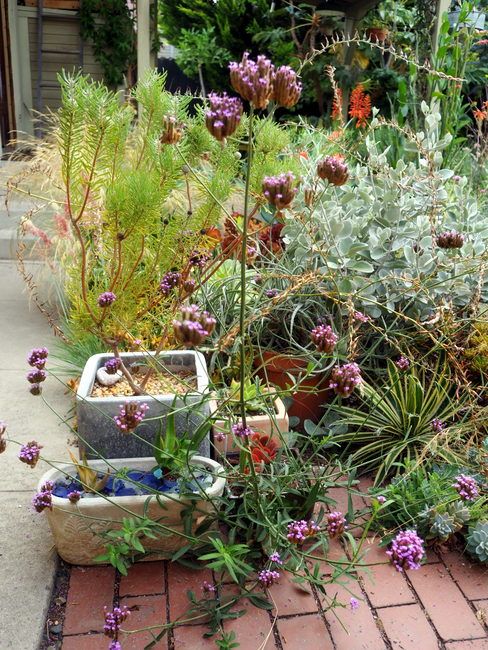
Verbena bonariensis is mostly finished, except for one seeded into the bricks.
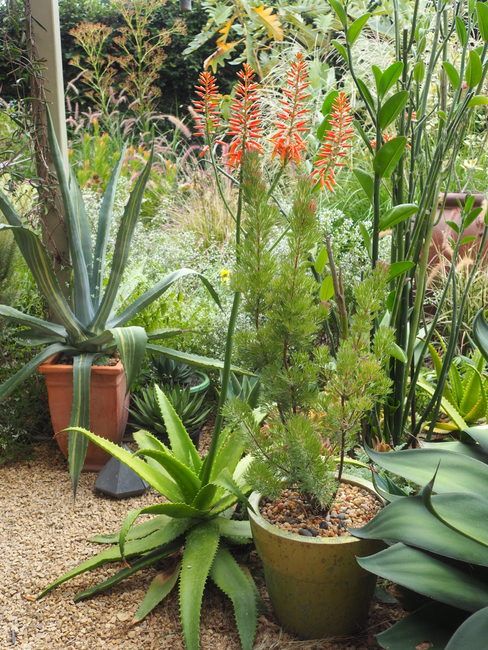
Several plants of Aloe ‘Cynthia Giddy’ dotted throughout the back garden continue to make rod-straight torches 3 feet tall, which completely satisfies my craving for strong verticals throughout summer. The big succulent leaves of Pedilanthus bracteatus are to the right, lightly in bloom now too.
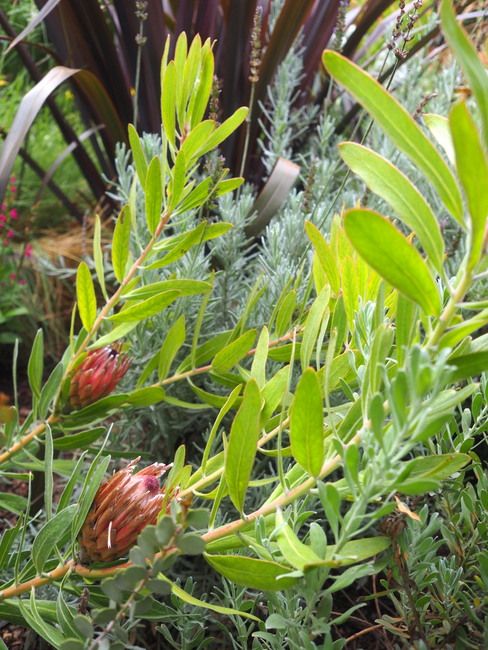
Protea ‘Pink Ice’ threw its first two blooms this summer. I poured the water on all summer to get it established, something I apparently failed at with two leucospermums.
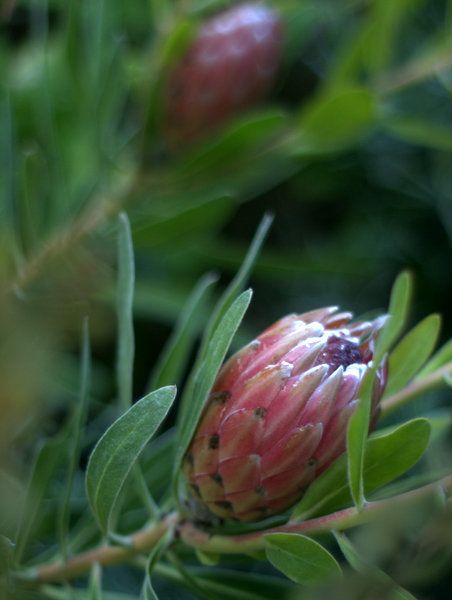
It’s always a surprise how much care and vigilance future drought-tolerant shrubs need to become established. If you hand water like I do, slip-ups happen. A lot.

A container filled with white cosmos was added in August, with some dark purple sweet potato vines, and that wraps up another Bloom Day report, fall-planting edition.

Given our geographic proximity, I’m always surprised at how different your garden is than my own in terms of what you can grow that I seemingly cannot, like the passionflowers, chocolate flower, many of your grasses, and of course the poppies. I have relatively poor results with most Salvias too, although I’ve not tried S. chiapensis so perhaps I’ll give it a spin. My ‘Pink Ice’ has yet to bloom and I’m toying with the idea of moving it from its large pot into the ground to improve its chances of doing so.
Vase shaped and Non drooping …perfect ! I’ll look it up for the PNW hardiness ?
@Kris, another salvia I planted again this fall was ‘Waverly’ – same thing with the leaves, fairly tough, but Waverly’s growth habits are larger and more chaotic. You have the space for both these salvias, and fall planting would be perfect. The choc flower and the poppies are reliable for me, but who knows about some of these passionflower hybrids? And all bets are off that Pink Ice actually grows into a shrub!
@Linda, it’s zoned 8-10 (https://www.anniesannuals.com/plants/view/?id=2029)
Your reports and photos have made me want all the Pennisetums. Space isn’t such an issue here, and they add movement and color over such a long period. Could be they’d take quite a bit longer to plume up here, but I’m pretty sure they’d be on the job by late summer, when this garden could definitely use a lift.
Salvias were already on the list, because there isn’t nearly enough for the hummingbirds here after the 4th of July. They appear to subsist on hosta blooms, the last of which are now gone. Wish I had an H&H close at hand! Actually, there’s a small nursery at the other end of the county that might have some potted salvias; a jaunt up there has a lot more appeal than the job of trimming all the bearded iris foliage…
Is the ‘Fast Forward’ muhly grass so named because it colors up earlier than the species, or just because of that excellent blur effect?
Next year at this time, I hope to be congratulating myself on the way ‘ White Cloud’ muhly sets off the stiff, dark, reddening foliage of smokebush and dwarf barberry. The idea came two years ago, but is still just that. Third spring’s a charm!
@Nell, September is a good time for a nursery jaunt! There’s a couple nurseries/growers here in power easements that churn out great plant stock, nothing rare, but a solid selection. Lucky you, with space not an issue — I’m forgetting what zone you’re in, but late summer can be amazing. Do you read Nan Ondra’s Hayefield blog? Case in point, using mostly herbaceous stuff. And that’s my understanding of the muhly’s name, that it blooms earlier than the species.
@Kris, I forgot to add that a possible difference in our gardens is that mine is enclosed whereas yours is exposed — that could make a difference.
I enjoy all your plant experiments and the constant rotations in and out. A clever response to the challenges of gardening in a smaller space. I was hoping to cut many ‘Pink Ice’ for the vase, but almost all the flowers have long trios of new growth above them–future flowers that will be lost. What to do?
‘Cynthia Gitty’ is a juggernaut of flowers in late summer. The Hummers approve.
@Hoov, small garden, long growing season — works for me. I’ve got a tiny Aloe tomentosa to join CG for summer bloom if/when it sizes up.
“It’s always a surprise how much care and vigilance future drought-tolerant shrubs need to become established.” Oh my goodness, yes! My “dry garden” has been anything but this summer, with everything having only been planted last fall. Next year, though, watering will be minimal in the dry areas, thank goodness.
I love your bloom day selection. I’m itching to start planting, too. I may be able to start next weekend.
Just beautiful! I too have had great luck with that salvia… such lovely, airy spikes for such a long bloom period! & so many hummingbirds :).
:: nurseries/growers here in power easements ::
This puzzled me no end until I realized what it probably means: land is so expensive that the only way for nurseries to find affordable space is in the right-of-ways for power lines? Wow.
@Evan, I loved your recent tour of all the work you’ve been doing. Your dry garden should be settling in well in a year or so.
@Holly, salvias can become quite an obsession!
@Nell, you’ve got it exactly right, unfortunately.
These are beautiful flowers. I would love to have them in my garden.